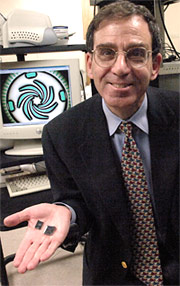Challenges ahead
The MIT team has now used this process to make all the components needed for their engine, and each part works. Inside a tiny combustion chamber, fuel and air quickly mix and burn at the melting point of steel. Turbine blades, made of low-defect, high-strength microfabricated materials, spin at 20,000 revolutions per second—100 times faster than those in jet engines. A mini-generator produces 10 watts of power. A little compressor raises the pressure of air in preparation for combustion. And cooling (always a challenge in hot microdevices) appears manageable by sending the compression air around the outside of the combustor.
“So all the parts work….We're now trying to get them all to work on the same day on the same lab bench," Epstein said. Ultimately, of course, hot gases from the combustion chamber need to turn the turbine blades, which must then power the generator, and so on. “That turns out to be a hard thing to do," he said. Their goal is to have it done by the end of this year.
Predicting how quickly they can move ahead is itself a bit of a challenge. If the bonding process is done well, each microengine is a monolithic piece of silicon, atomically perfect and inseparable. As a result, even a tiny mistake in a single component will necessitate starting from scratch. And if one component needs changing—say, the compressor should be a micron smaller—the microfabrication team will have to rethink the entire design process.
For all the difficulties, Epstein said the project is “an astonishing amount of fun"—and MIT is the ideal place for it. “Within 300 feet of my office, I could find the world's experts on each of the technologies needed to make the complete system," he said.
In addition, the project provides an excellent opportunity for teaching. “No matter what your specialty is—combustion or bearings or microfabrication—it's equally hard," he said. “As an educational tool, it's enormously useful because the students realize that their success is dependent upon other people's success. They can't make their part easier by making somebody else's part harder because then as a team we don't succeed.”


